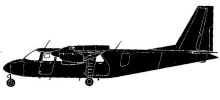
ASN Wikibase Occurrence # 322439
| Date: | Tuesday 15 March 2005 |
| Time: | 00:18 |
| Type: |  Pilatus Britten-Norman BN-2B-26 Islander |
| Owner/operator: | Loganair |
| Registration: | G-BOMG |
| MSN: | 2205 |
| Year of manufacture: | 1989 |
| Total airframe hrs: | 6221 hours |
| Cycles: | 40018 flights |
| Engine model: | Lycoming O-540-E4C5 |
| Fatalities: | Fatalities: 2 / Occupants: 2 |
| Aircraft damage: | Destroyed, written off |
| Category: | Accident |
| Location: | 14 km WNW Campbeltown-Machrihanish Airport (CAL) -
 United Kingdom United Kingdom
|
| Phase: | Approach |
| Nature: | Ambulance |
| Departure airport: | Glasgow International Airport (GLA/EGPF) |
| Campbeltown-Machrihanish Airport (CAL/EGEC) | |
| Confidence Rating: |
The Glasgow based Islander aircraft was engaged on an air ambulance task for the Scottish Ambulance Service when the accident occurred. The pilot allocated to the flight had not flown for 32 days; he was therefore required to complete a short flight at Glasgow to regain currency before landing to collect a paramedic for the flight to Campbeltown Airport.
Poor weather at Campbeltown Airport necessitated an instrument approach. There was neither radar nor Air Traffic Control Service at the airport, so the pilot was receiving a Flight Information Service from a Flight Information Service Officer in accordance with authorised procedures. After arriving overhead Campbeltown Airport, the aircraft flew outbound on the approach procedure for runway 11 and began a descent. The pilot next transmitted that he had completed the base turn, indicating that he was inbound to the airport and commencing an approach. The airplane had gradually descended below the minimum altitude With a slight left wing low attitude, the airplane contacted the sea. It broke up after impact and sank.
CAUSAL FACTORS:
"1. The pilot allowed the aircraft to descend below the minimum altitude for the aircrafts position on the approach procedure, and this descent probably continued unchecked until the aircraft flew into the sea.
2. A combination of fatigue, workload and lack of recent flying practise probably contributed to the pilots reduced performance.
3. The pilot may have been subject to an undetermined influence such as disorientation, distraction, or a subtle incapacitation,which affected pilots ability to safely control the aircrafts flightpath."
Sources:
AAIB Aircraft Accident Report No: 2/2006
Location
Revision history:
| Date/time | Contributor | Updates |
|---|
The Aviation Safety Network is an exclusive service provided by:


 ©2024 Flight Safety Foundation
©2024 Flight Safety Foundation